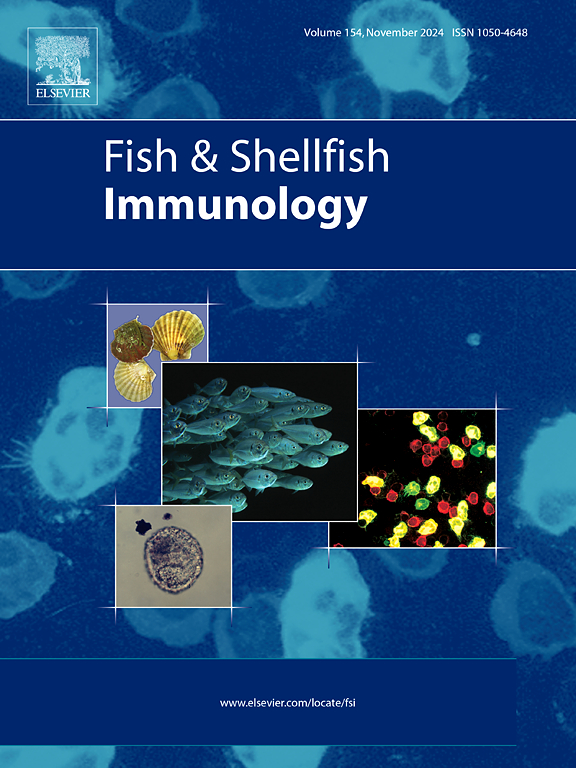A newly identified homolog of scallop caspase-3/7 plays a pivotal role in the immunological response and orchestrates the induction of apoptosis
IF 3.9
2区 农林科学
Q1 FISHERIES
引用次数: 0
Abstract
Chlamys farreri, commonly known as the Zhikong scallop, holds considerable value in global mariculture due to its economic importance. However, diseases pose a major threat to the scallop aquaculture industry. Thus, investigating the innate immune mechanisms of scallops, including the apoptosis mechanism, holds significant importance for the prevention and control of diseases. In this study, an executioner Caspase gene was isolated from the Zhikong scallop (Cf-Caspase-3/7-1), and its functional characteristics were explored. The complete open reading frame of Cf-Caspase-3/7-1 is 1698 base pairs in length, encoding a polypeptide composed of 566 amino acids. The analysis of the protein function domain revealed the existence of a conserved Caspase catalytic domain (CASc) in the C-terminal of Cf-Caspase-3/7-1. Phylogenetic analysis confirmed that Cf-Caspase-3/7-1 belongs to the molluscan Caspase-3/7 subfamily. qRT-PCR analysis showed that Cf-Caspase-3/7-1 mRNA is expressed in all the tissues investigated, with the highest transcript abundance observed in the gills. Additionally, its expression was mainly caused by various pathogenic molecular patterns, including lipopolysaccharide, polyinosinic: polycytidylic acid, peptidoglycan, and the acute viral necrosis virus. Overexpression of Cf-Caspase-3/7-1 in HEK293T cells induced dose-dependent NF-κB reporter genes activation and apoptosis, as shown by distinct morphological changes and increased Caspase-3/7 activity. Our findings provide a new perspective on the mechanism of action of the Caspase gene in mollusks and facilitate the advancement of comparative immunology as well as the sustainable development of the scallop aquaculture industry.
一个新发现的扇贝caspase-3/7同源物在免疫反应中起关键作用,并协调诱导细胞凋亡
栉孔扇贝,俗称芝孔扇贝,由于其经济重要性,在全球海水养殖中占有相当大的价值。然而,疾病对扇贝养殖业构成了重大威胁。因此,研究扇贝的先天免疫机制,包括细胞凋亡机制,对疾病的预防和控制具有重要意义。本研究从直孔扇贝中分离到一个刽子手Caspase基因(cf -Caspase 3/7-1),并对其功能特征进行了探讨。Cf-Caspase-3/7-1的完整开放阅读框长度为1698个碱基对,编码566个氨基酸组成的多肽。蛋白质功能域分析显示,Cf-Caspase-3/7-1的c端存在一个保守的Caspase催化结构域(CASc)。系统发育分析证实Cf-Caspase-3/7-1属于软体动物Caspase-3/7亚家族。qRT-PCR分析显示,Cf-Caspase-3/7-1 mRNA在所有研究组织中均有表达,其中在鳃中转录丰度最高。此外,其表达主要由多种致病分子模式引起,包括脂多糖、多肌苷、多胞酸、肽聚糖和急性病毒坏死病毒。在HEK293T细胞中过表达Cf-Caspase-3/7-1可诱导剂量依赖性NF-κB报告基因激活和凋亡,表现为明显的形态学改变和Caspase-3/7活性升高。本研究结果为研究Caspase基因在软体动物中的作用机制提供了新的视角,有助于比较免疫学的发展和扇贝养殖业的可持续发展。
本文章由计算机程序翻译,如有差异,请以英文原文为准。
求助全文
约1分钟内获得全文
求助全文
来源期刊

Fish & shellfish immunology
农林科学-海洋与淡水生物学
CiteScore
7.50
自引率
19.10%
发文量
750
审稿时长
68 days
期刊介绍:
Fish and Shellfish Immunology rapidly publishes high-quality, peer-refereed contributions in the expanding fields of fish and shellfish immunology. It presents studies on the basic mechanisms of both the specific and non-specific defense systems, the cells, tissues, and humoral factors involved, their dependence on environmental and intrinsic factors, response to pathogens, response to vaccination, and applied studies on the development of specific vaccines for use in the aquaculture industry.
 求助内容:
求助内容: 应助结果提醒方式:
应助结果提醒方式:


